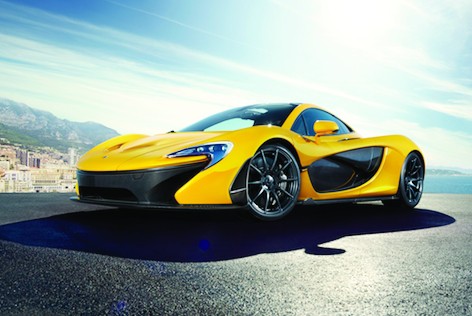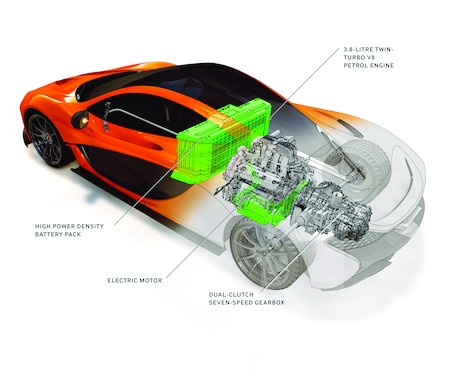It’s still quite a novelty to write about a world-beating British sports car in the present tense. Until the last couple of years, the glory days of the ‘Made in Britain’ sports car was firmly in the past, and the super- and hypercars gathering droll-encrusted reviews on Top Gear all had pronounced German or Italian accents.
The turnaround has been thanks to motorsport (a sector where Britain has been leading the world for some time, mostly under the general public’s radar) and, in particular, to one of the industry’s most charismatic, if not downright intimidating individuals: Ron Dennis of McLaren. For a company that only retails four car models, McLaren Automotive is clearly punching above its weight, with its two main products — the MP4-12C and, this year’s addition, the P1 — gaining favourable comparisons with Ferraris and Porsches.
The man charged with making Ron Dennis’s dreams of sports car domination a reality is Paul Mackenzie, executive director of McLaren Special Operations, whose most recent role was overseeing the design, development and launch of the McLaren P1, the company’s first tilt at the very top end of the performance road-car market.
Only 375 P1s will ever be produced and, at £865,000 each, the vast majority of us will probably never even see one, let alone get to ride in one or even drive it. But in this strange, elitist market, that’s the point, Mackenzie explains after addressing this year’s Niche Vehicle Network symposium. ‘Exclusivity is a very important purchasing factor in for this type of car,’ he said, adding that working out the right number to produce and how much it should cost were difficult decisions for the McLaren Automotive team.
Fortunately for The Engineer, Mackenzie brought a P1 along to the symposium, so we can at least say we saw one in the bodywork (although we didn’t get a ride). It’s certainly a striking vehicle and very different from the MP4-12C; lower, curvier, looking more ‘fast’, even when standing still in a car park.

In engineering terms, it’s one of a new breed of sports cars in that it’s a hybrid, with an electric motor supplementing its petrol engine. This, Mackenzie says, was not part of the original brief for the vehicle. ‘We didn’t set out specifically to design a hybrid, absolutely not,’ he said. ‘Our original brief was to make the best sports car on the planet — not necessarily the fastest in a straight line, or even the fastest on the track, but for best for drivers who like the sheer experience, the sensation and the activity of driving performance vehicles.’
So how did McLaren come to design not just a plug-in hybrid, but one where the petrol engine can be disengaged, leaving the car able to operate as a pure electric vehicle? The original impetus, Mackenzie says, came from again looking at what buyers considered important. He was surprised, he admitted, that even in the 150mph+ world of the hypercar, fuel economy was rated quite highly on prospective customers’ list of priorities.
‘We looked at all the ways that we could achieve that while staying within the performance envelope we wanted the car to occupy,’ he says, ‘and our team came to the conclusion that adding an electric motor would not only improve fuel economy, but it could also be performance-enhancing.’
They key to this is in the engine. Like most performance cars, the P1’s engine is turbocharged and this means that it inherently suffers from turbo lag — put your foot on the accelerator and it’ll take a little while for the turbocharger to kick in — the exhaust gases that drive the turbos have to come up to pressure and the turbos themselves have to ‘spin up’. The result is that the extra torque the turbochargers provide is only available after a short delay.
McLaren P1 vital statistics
- Powertrain
- 3.8L twin-turbo V8 plus single electric motor
- Power
- Total 903bhp
- Electric mode
- Range on full charge 10km
- Acceleration
- 0–100km/hr 3sec
- 0–200km/hr 7sec
- 0–300km/hr 17sec
- Top speed (limited) 350km/hr
- Carbon emissions below 200g/km
- Instant power-assist system derived from Formula 1 KERS
- Drag-reduction system derived from F1
- Brake steer
But electric motors provide instant torque. ‘Our powertrain engineers said: “You know that thing with the turbo-lag? We can eliminate that”,’ Mackenzie says. ‘You can rewrite what the car’s demand and power curve look like. And from that, we decided that a combination of electric and petrol was the way to go, but we hadn’t decided on the architecture, whether we’d use multiple motors, in-line motors, front axle, rear axle.’ Mackenzie remembers driving an early mule version of the car — a trial version of the mechanical components — with a 15kg weight bolted onto the front uprights to give an idea of how the mass distribution on the front axle would affect the car’s handling.
‘What we actually found was that we didn’t want to mess around with the front axle too much,’ he says. ‘One of our key deliverables was the purity of the feel of driving and, from the point of view of steering and driving, keeping the front axle clean was very important.’ The team came up with an arrangement where the electric motor hangs off the side of the engine block, connected to it via a 50mm-thick intermediate clutch and gear that allows the engine to be disengaged. This allows the car to be driven in E-mode in town and in traffic jams, making for a smoother ride and much less petrol consumption, Mackenzie says — he’d used E-mode himself on the way to the seminar. ‘The engine also charges the motor’s batteries, of course, making it a range-extender. But the electric motor alone provides 176bhp — much more than the petrol engine on even quite powerful normal family cars.’ With the petrol engine — a 3.8-litre twin-turbo V8, built like the MP4-12C’s engine by Ricardo — that power output leaps to 903bhp, which will take the car from 0 to 300km/hr in less than 17 seconds.

McLaren presented the P1 in public ahead of its main competitors, Porsche and Ferrari, and Mackenzie says the team was pleasantly surprised to find that both marques had hit on similar hybrid powertrain solutions for the 918 and LaFerrari models respectively, ‘although the architectures are different; the 918 uses multiple motors, and the Ferrari has the motor hanging off the back of the gearbox. It’s convergent evolution; we’ve all come to the conclusion that electric plus petrol equals efficiency and performance’.
Other engineering innovations in the car include active aerodynamics on the rear wing and underbody, which adjust the downforce on the rear of the car depending on the road speed, and an enhanced version of the carbon-fibre monocoque tub from the 12C with the roof structure and ‘snorkel’ air intake integral to the structure. The aerodynamics are designed so that the intakes for the engine and the brakes receive ‘clean’ non-turbulent air, which enhances the performance of both. ‘The fact is, this is an expensive car, and that gives us an ability to play around with some technologies that we can’t use on our more mainstream cars.’ We can certainly expect to see fewer bells and whistles on the next car from the Woking stable, which will be an ‘entry-level’ sports car much cheaper than the 12C — although, unsurprisingly, Mackenzie refuses to give any information on what features that car, the P13, might have, or when it might appear.
Unlike other hypercars — notably the loss-making Bugatti Veyron — the P1 has to fit into a strict business plan. ‘We’re a small company and we’re still developing. We’ve always had this three-platform approach with the 12C first, then the P1, then P13 — but we can’t afford loss-leaders. The P1 is a profit-making project.’
The rationale behind performance vehicles such as the P1 is generally that they form a platform to launch technologies and materials that filter down to more conventional vehicles, but Mackenzie admits that McLaren does not have any agreements in place with volume producers to adapt its innovations. ‘We’re certainly open to anyone coming in to discuss that with us,’ he says.
Paul Mackenzie
Executive director of McLaren Special Operations
Education
1993: Graduated Plymouth University with a BEng Hons in composites engineering
Career
1993–1999: GEC Marconi Materials Technology Ltd. Engineer/project manager. Stealth projects for the defence industry
1999–2003: McLaren Composites. Project manager responsible for the development of the Mercedes McLaren SLR carbon-fibre chassis and body system
2003—2014: McLaren Automotive. Programme director responsible for the delivery of the SLR-coupe, roadster, 722, 722S, Stirling Moss and McLaren P1
2014 (current): McLaren Automotive. Executive director of McLaren Special Operations. Responsible for McLaren Automotive’s bespoke division





Project to investigate hybrid approach to titanium manufacturing
What is this a hybrid of? Superplastic forming tends to be performed slowly as otherwise the behaviour is the hot creep that typifies hot...